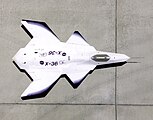English: This look-down view (
planform) of the X-36 Tailless Fighter Agility Research Aircraft on the ramp at NASA's Dryden Flight Research Center, Edwards, California, clearly shows the unusual wing and canard design of the remotely-piloted aircraft. The
NASA/Boeing X-36 Tailless Fighter Agility Research Aircraft program successfully demonstrated the tailless fighter design using advanced technologies to improve the maneuverability and survivability of possible future fighter aircraft. The program met or exceeded all project goals. For 31 flights during 1997 at the Dryden Flight Research Center, Edwards, California, the project team examined the aircraft's agility at low speed / high angles of attack and at high speed / low angles of attack. The aircraft's speed envelope reached up to 206 knots (234 mph). This aircraft was very stable and maneuverable. It handled very well. The X-36 vehicle was designed to fly without the traditional tail surfaces common on most aircraft. Instead, a canard forward of the wing was used as well as split ailerons and an advanced thrust-vectoring nozzle for directional control. The X-36 was unstable in both pitch and yaw axes, so an advanced, single-channel digital fly-by-wire control system (developed with some commercially available components) was put in place to stabilize the aircraft. Using a video camera mounted in the nose of the aircraft and an onboard microphone, the X-36 was remotely controlled by a pilot in a ground station virtual cockpit. A standard fighter-type head-up display (HUD) and a moving-map representation of the vehicle's position within the range in which it flew provided excellent situational awareness for the pilot. This pilot-in-the-loop approach eliminated the need for expensive and complex autonomous flight control systems and the risks associated with their inability to deal with unknown or unforeseen phenomena in flight. Fully fueled the X-36 prototype weighed approximately 1,250 pounds. It was 19 feet long and three feet high with a wingspan of just over 10 feet. A Williams International F112 turbofan engine provided close to 700 pounds of thrust. A typical research flight lasted 35 to 45 minutes from takeoff to touchdown. A total of 31 successful research flights were flown from May 17, 1997, to November 12, 1997, amassing 15 hours and 38 minutes of flight time. The aircraft reached an altitude of 20,200 feet and a maximum angle of attack of 40 degrees. In a follow-on effort, the Air Force Research Laboratory (AFRL), Wright-Patterson Air Force Base, Ohio, contracted with Boeing to fly AFRL's Reconfigurable Control for Tailless Fighter Aircraft (RESTORE) software as a demonstration of the adaptability of the neural-net algorithm to compensate for in-flight damage or malfunction of effectors, such as flaps, ailerons and rudders. Two RESTORE research flights were flown in December 1998, proving the viability of the software approach. The X-36 aircraft flown at the Dryden Flight Research Center in 1997 was a 28-percent scale representation of a theoretical advanced fighter aircraft. The Boeing Phantom Works (formerly McDonnell Douglas) in St. Louis, Missouri, built two of the vehicles in a cooperative agreement with the Ames Research Center, Moffett Field, California.





